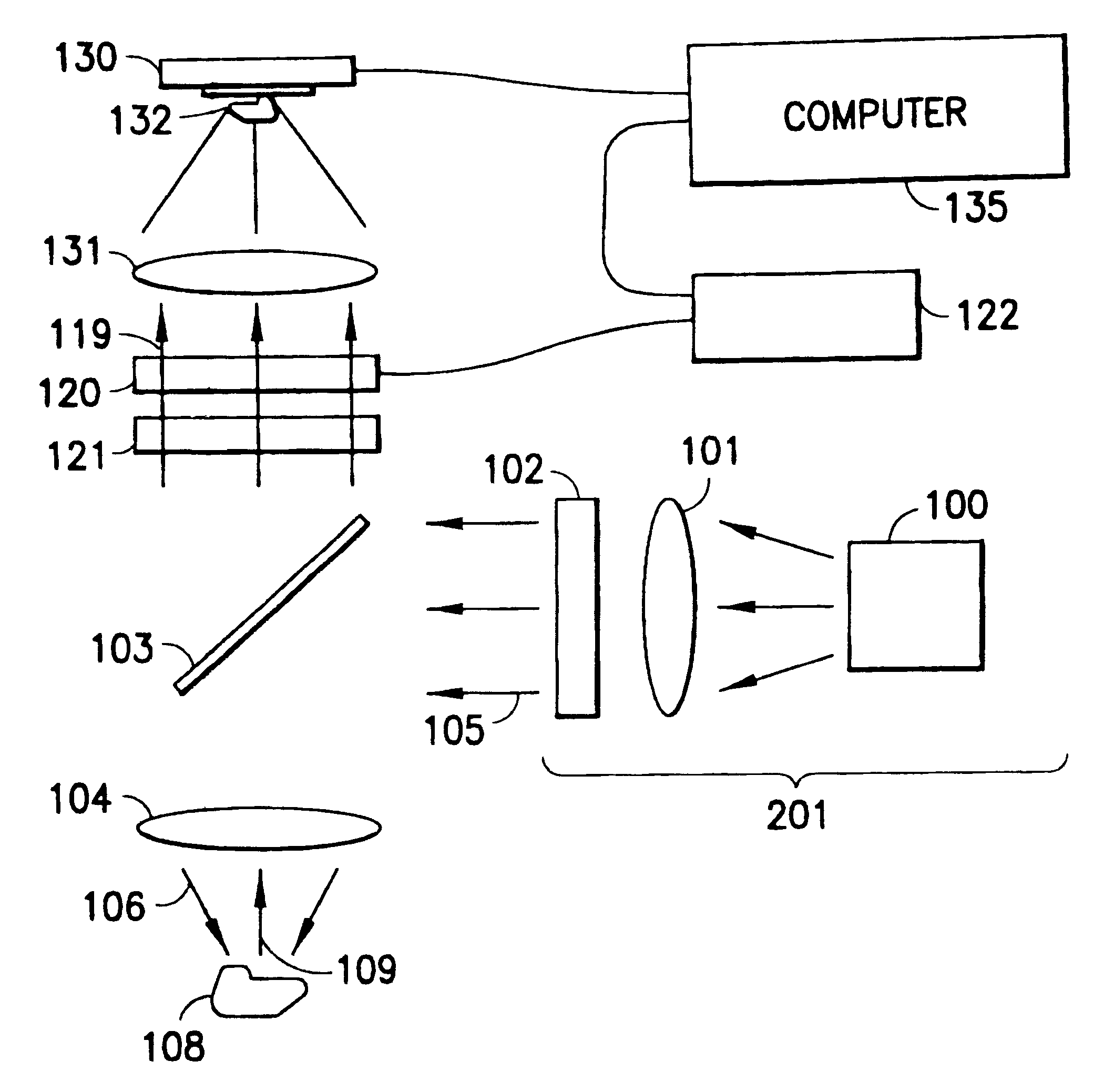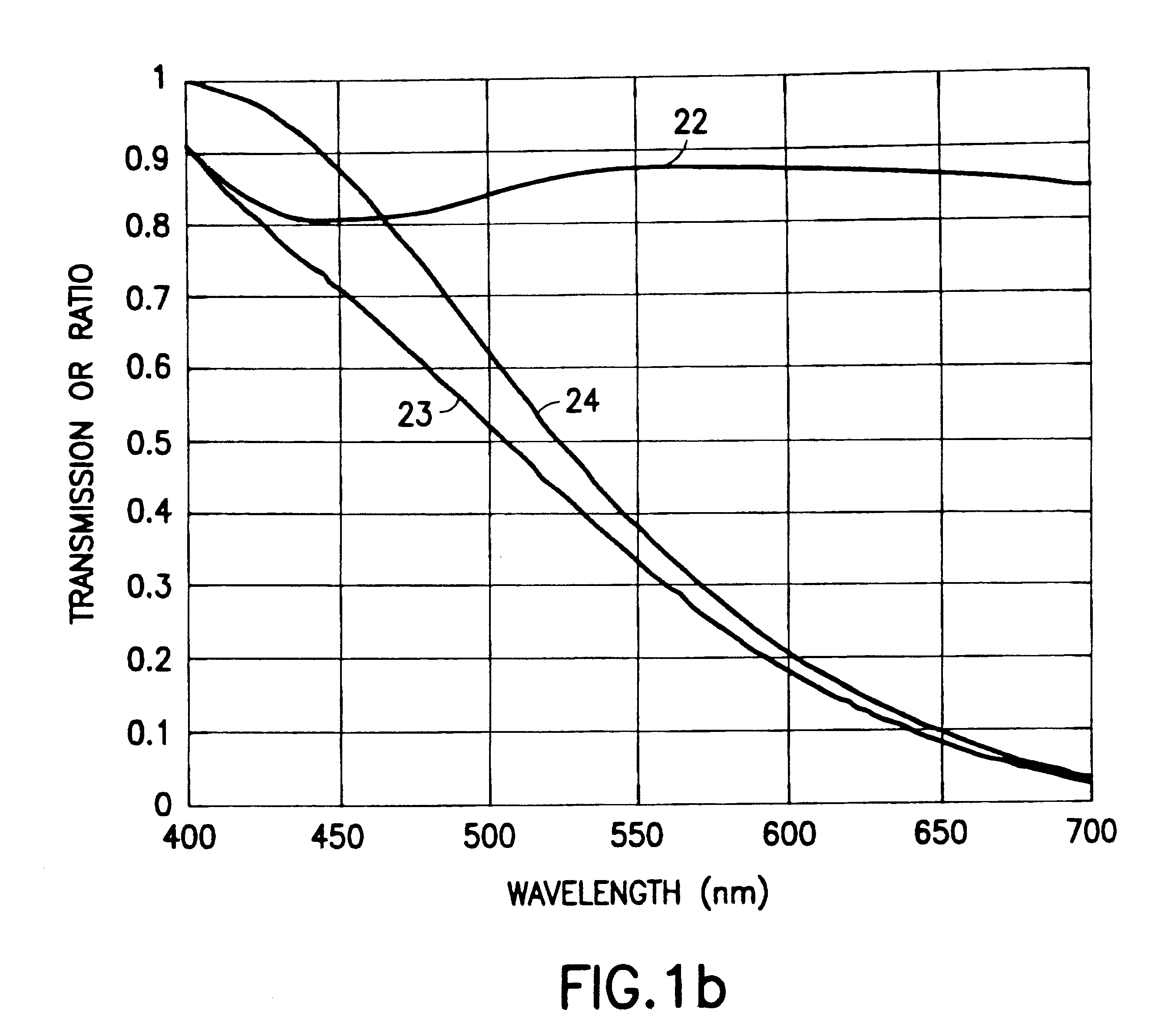Yet this is hardly an integrated, efficient solution to the problem.
However, all the foregoing imaging suffer from significant limitations.
Imaging spectroscopic methods require complex and rather expensive hardware, and involve taking at least N exposures, using optical elements of relatively low efficiency.
Multiple, long exposures are required, which limits
throughput and is impractical with probes that photobleach rapidly.
However, this
system has several weaknesses.
This leads to reduced optical sensitivity.
Second, it is exquisitely sensitive to shifts in the
wavelength of emission by the probes, as a shift of one-eighth of the emission width could lead to misidentification of which species was involved.
Yet there is no way to use this
photometer with more widely-spaced probes, as it relies on the overlap of at least N-1 of the N species within each of the two
photometer bands.
These photometric
wavelength-detection systems are inherently non-imaging, in that they provide a wavelength indication for the whole beam of light, and cannot determine the wavelength at a plurality of separate points within an image.
However, in the vast majority of bio-medical applications, this is a severe limitation.
Even in gel
chromatography, this results in poor utilization of equipment.
The
plate reader is occupied for the entire duration of the gel separation, which can take hours; the alternative of a lengthy separation using an inexpensive instrument, followed by a rapid readout cycle in the more costly reader, is impossible.
However, for this purpose there is little reason to choose these systems over alternatives such as e.g. a
fiber-coupled
diode-array
spectrometer, which would provide more reliable spectral information with better utilization of the scarce emitted photons.
The additional complexity of the
scanner typically cancels out any innate simplification in the photometric wavemeter component.
Nor do any prior-art wavelength-measuring systems provide means for directly producing a two-dimensional image with a two-dimensional sensor.
Those which involve Fourier methods to determine wavelength are probably ill-suited to a taking a high-definition image, due to the computation requirements when the number of pixels is large.
Systems using two detectors face a significant
cost burden over one-
detector systems, as the cost of a two-dimensional imaging sensor such as a CCD is high.
Any error in the
spatial registration of the multiple exposures degrades the numerical accuracy of the ratio scheme involved, since if readings from the two detectors come from different spatial regions in the sample, there is no way to take their ratio and determine a wavelength.
Spatial registration of two detectors to a fraction of one pixel is a challenging and expensive proposition.
This mechanical switching leads to image shift from the unavoidable wedge in the filter elements, which corrupts the ratio used to derive a wavelength measurement.
Other practical considerations confound the extension of existing point-measuring photometric systems into imaging systems.
The Prober photometer exhibits poor
optical efficiency, since only a small portion of the sample emission is utilized by any given photometer band, even the most responsive band.
This deficiency is even more problematic in an imaging system, where the desire for
high spatial resolution favors the use of imaging detectors with many pixels; this in turn means that the
radiant energy is partitioned between a great number of pixels, which exacerbates the
signal-to-
noise requirements.
This arrangement is not capable of imaging a two-dimensional scene.
Simply replacing the
photodiode or
photomultiplier tube (PMT) of Buican with a two-dimensional imaging
detector such as a CCD, is impractical if not absolutely impossible.
In summary, the aforementioned art provides equipment and methods for
hyperspectral imaging to produce high-definition images of multiple probes in a sample, but these require at least N observations to resolve N probes and use relatively expensive, optically inefficient hardware.
However, these are point-measuring systems that cannot provide an image of the sample unless one adds mechanical or
optical scanning means, which undermines the cost and performance benefits of this approach.
And, attempts to extend this art to construct systems with two-dimensional imaging sensors are impractical for at least one of the following reasons in every case: the need for multiple imaging detectors; the need to register multiple images obtained from different detectors, or from a single
detector with multiple filters, to much better than a
single pixel; poor
optical efficiency; the need for mechanical
moving parts; intensive computing requirements; or, the need to operate at sample rates far above the capability of imaging detectors.
 Login to View More
Login to View More  Login to View More
Login to View More 


